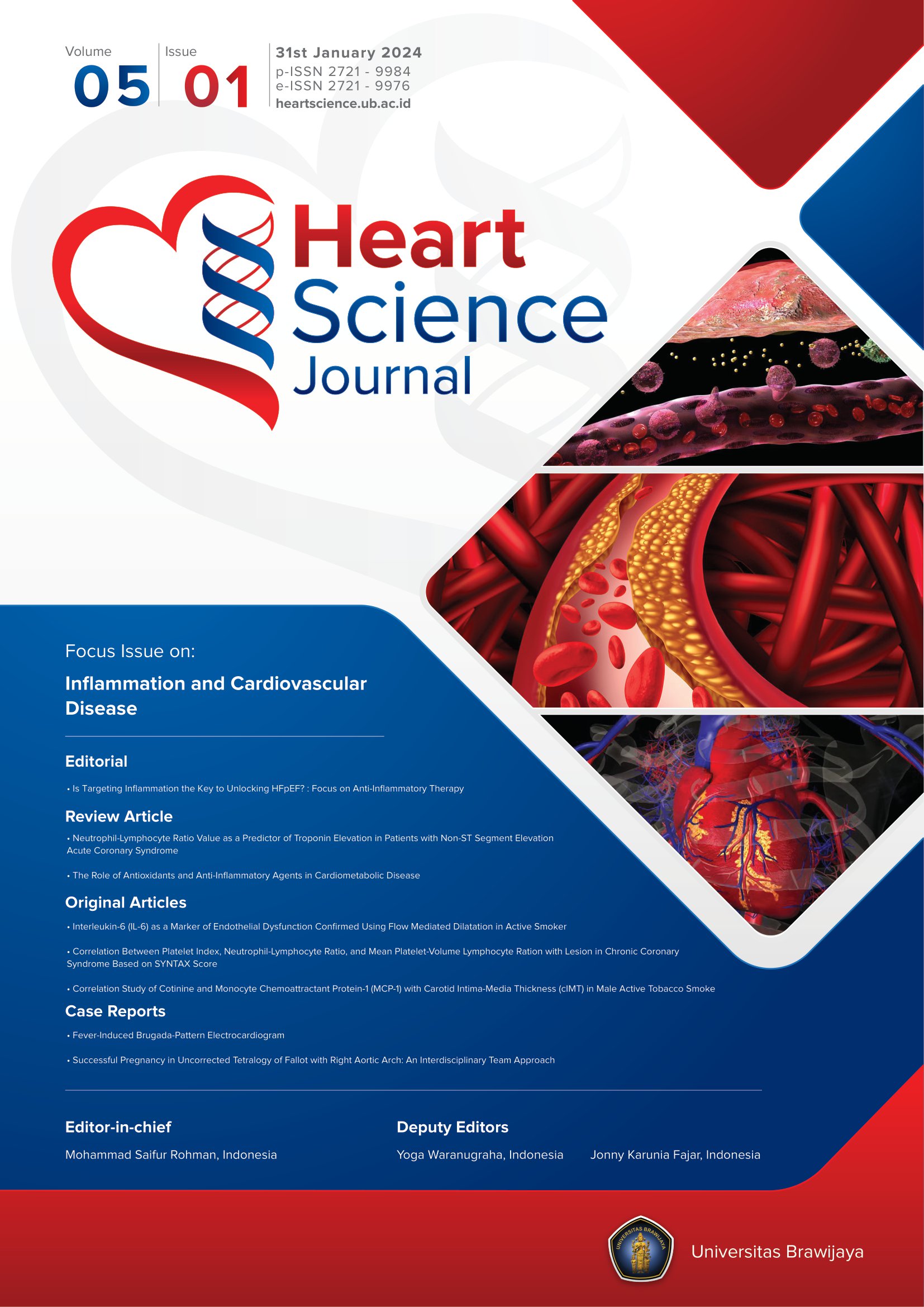Is There A Role of Glycated Hemoglobin for Predicting Major Ad- verse Cardiac Event in ST-Elevation Myocardial Infarction?
Abstract
Background : Coronary Artery Disease (CAD) especially ST-Elevation Myocardial Infarction (STEMI) is the leading cause of mortality worldwide. Hyperglycemia and diabetes mellitus are both prevalent among patients with STEMI admitted to the hospital. Glycated hemoglobin (HbA1c) is a marker of glucose control.
Objectives : We aimed to investigate the role of HbA1c as the predictor of major adverse cardiovascular events in STEMI patients.
Methods : This was a retrospective cohort study. STEMI patients visiting Saiful Anwar General Hospital were registered. Patients were divided into three groups based on the HbA1c level <6.5%; 6.5-8.4% and ≥8.5%; respectively. The primary endpoint was in-hospital Major Adverse Cardiovascular Events (MACE), including cardiac death, recurrent myocardial infarction (MI), recurrent revascularization, acute pulmonary edema, cardiogenic shock, malignant arrhythmia, and stroke.
Results: A total of 118 STEMI patients were included in this study, with distribution of 61 patients with HbA1c <6.5%, 25 patients with HbA1c 6.5-8.4%, and 31 patients with HbA1c ≥8.5%; respectively. The HbA1C level was associated with the history of diabetes mellitus (3.2% vs 36% vs 71%; p =0.000) and random blood glucose level at hospital admission (140.71 ± 39.67 mg/dL vs 172.96 ± 53.43 mg/dL vs 366.61 ± 169.67 mg/dL; p = 0.000). The MACE among three groups was not significantly different (17.7% vs 20% vs 35.5%; p=0,149). Conclusion: Our study reveals that the HbA1c level at hospital admission is associated with the history of diabetes mellitus and random blood glucose at hospital admission. However, HbA1c could not predict MACE in STEMI patients
Keywords
Full Text:
PDFReferences
Joshi R, Alim M, Kengne AP, et al. Task shifting for non-communica- ble disease management in low and middle income countries–a systematic review. PloS one 2014;9:e103754.
Zhao Z, Winget M. Economic burden of illness of acute coronary syndromes: medical and productivity costs. BMC health services research 2011;11:35.
Ibanez B, James S, Agewall S, et al. 2017 ESC Guidelines for the management of acute myocardial infarction in patients presenting with ST-segment elevation: The Task Force for the management of acute myocardial infarction in patients presenting with ST-segment elevation of the European Society of Cardiology (ESC). European heart journal 2018;39:119-77.
Dai X, Kaul P, Smith Jr SC, Stouffer GA. Predictors, treatment, and outcomes of STEMI occurring in hospitalized patients. Nature Reviews Cardiology 2016;13:148.
Turner RC. The UK prospective diabetes study: a review. Diabetes care 1998;21:C35-C8.
Haghighatpanah M, Nejad ASM, Haghighatpanah M, Thunga G, Mallayasamy S. Factors that correlate with poor glycemic control in type 2 diabetes mellitus patients with complications. Osong public health and research perspectives 2018;9:167.
Lenters-Westra E, Schindhelm RK, Bilo HJ, Slingerland RJ. Haemo- globin A1c: Historical overview and current concepts. Diabetes Research and Clinical Practice 2013;99:75-84.
Yeung SLA, Luo S, Schooling CM. The impact of glycated hemoglo- bin (HbA1c) on cardiovascular disease risk: a Mendelian random- ization study using UK Biobank. Diabetes Care 2018;41:1991-7.
Corpus RA, O'Neill WW, Dixon SR, Timmis GC, Devlin WH. Relation of hemoglobin A1c to rate of major adverse cardiac events in nondiabetic patients undergoing percutaneous coronary revascular- ization. The American journal of cardiology 2003;92:1282-6.
Hadjadj S, Coisne D, Mauco G, et al. Prognostic value of admission plasma glucose and HbA1c in acute myocardial infarction. Diabetic medicine 2004;21:305-10.
Massi-Benedetti M. Changing targets in the treatment of type 2 diabetes. Current medical research and opinion 2006;22:S5-S13.
Leow MKS. Glycated Hemoglobin (HbA1c): Clinical Applications of a Mathematical Concept. Acta Informatica Medica 2016;24:233.
Committee IE. International Expert Committee report on the role of the A1C assay in the diagnosis of diabetes. Diabetes care 2009;32:1327-34.
Ma Q, Liu H, Xiang G, Shan W, Xing W. Association between glycat- ed hemoglobin A1c levels with age and gender in Chinese adults with no prior diagnosis of diabetes mellitus. Biomedical reports 2016;4:737-40.
Morrow DA, Antman EM, Charlesworth A, et al. TIMI risk score for ST-elevation myocardial infarction: a convenient, bedside, clinical score for risk assessment at presentation: an intravenous nPA for treatment of infarcting myocardium early II trial substudy. Circula- tion 2000;102:2031-7.
Timmer J, Ottervanger J, Bilo H, et al. Prognostic value of admission glucose and glycosylated haemoglobin levels in acute coronary syndromes. Journal of the Association of Physicians 2006;99:237-43.
Pusuroglu H, Akgul O, Cakmak HA, et al. Long-term prognostic value of admission haemoglobin A1c (HbA1c) levels in patients with ST-segment elevation myocardial infarction undergoing primary percutaneous coronary intervention. Postępy w Kardiologii Interwencyjnej= Advances in Interventional Cardiology 2014;10:166.
Hwang JK, Lee SH, Song YB, et al. Glycemic control status after percutaneous coronary intervention and long-term clinical outcomes in patients with type 2 diabetes mellitus. Circulation: Cardiovascular Interventions 2017;10:e004157.
Bruno RR, Kelm M, Jung C. Spotlight on comorbidities in STEMI patients. Endocrinology, Diabetes & Metabolism 2020;3:e00102.
Clement S, Braithwaite SS, Magee MF, et al. Management of diabetes and hyperglycemia in hospitals. Diabetes care 2004;27:553-91.
Sanjuán R, Núñez J, Blasco ML, et al. Prognostic implications of stress hyperglycemia in acute ST elevation myocardial infarction. Prospective observational study. Revista Española de Cardiología (English Edition) 2011;64:201-7.
Bakker W, Eringa EC, Sipkema P, van Hinsbergh VW. Endothelial dysfunction and diabetes: roles of hyperglycemia, impaired insulin signaling and obesity. Cell and tissue research 2009;335:165.
Mapanga RF, Essop MF. Damaging effects of hyperglycemia on cardiovascular function: spotlight on glucose metabolic pathways. American Journal of Physiology-Heart and Circulatory Physiology 2016;310:H153-H73.
Cakmak M, Cakmak N, Cetemen S, et al. The value of admission glycosylated hemoglobin level in patients with acute myocardial infarction. Canadian journal of cardiology 2008;24:375-8.
Gustafsson I, Kistorp CN, James MK, et al. Unrecognized glycometa- bolic disturbance as measured by hemoglobin A1c is associated with a poor outcome after acute myocardial infarction. American heart journal 2007;154:470-6.
DOI: https://doi.org/10.21776/ub.hsj.2020.001.03.4
Refbacks
- There are currently no refbacks.
Copyright (c) 2020 Muhammad Abusari

This work is licensed under a Creative Commons Attribution 4.0 International License.









